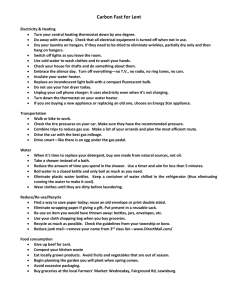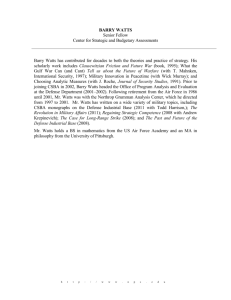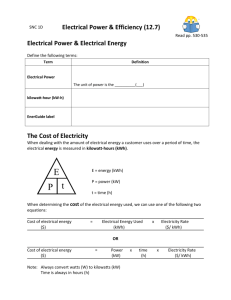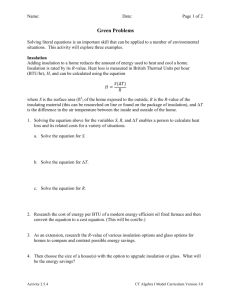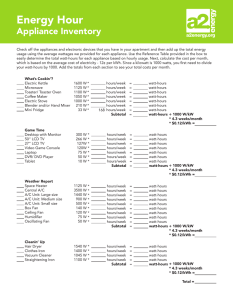Determining Watt-Hours Worksheet
advertisement
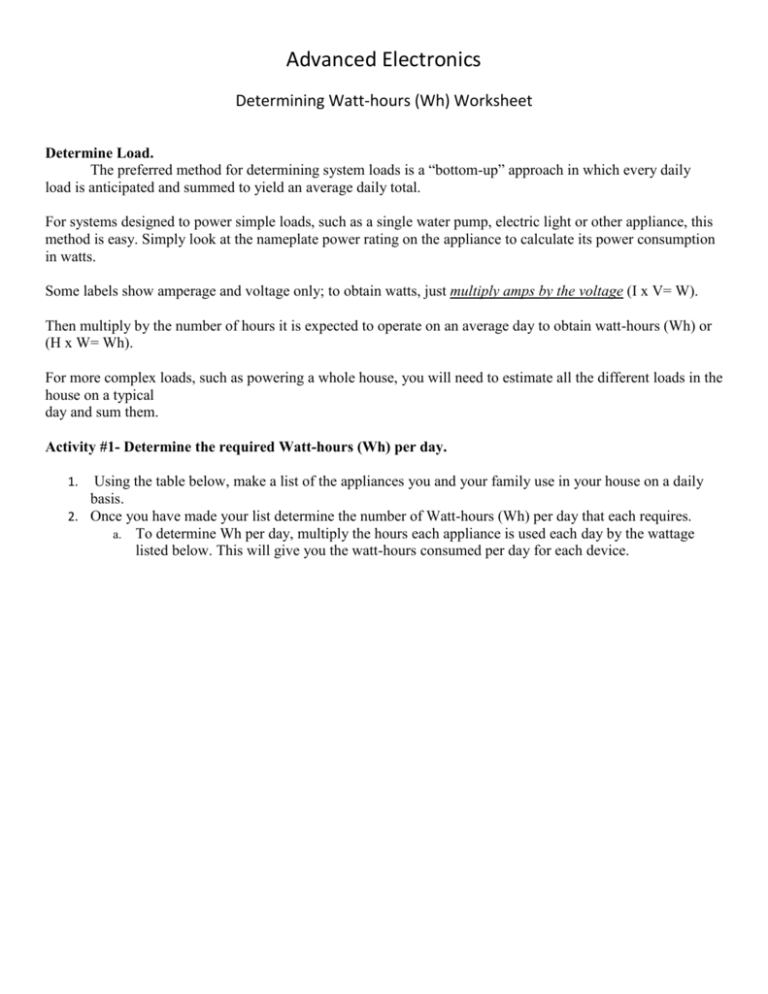
Advanced Electronics Determining Watt-hours (Wh) Worksheet Determine Load. The preferred method for determining system loads is a “bottom-up” approach in which every daily load is anticipated and summed to yield an average daily total. For systems designed to power simple loads, such as a single water pump, electric light or other appliance, this method is easy. Simply look at the nameplate power rating on the appliance to calculate its power consumption in watts. Some labels show amperage and voltage only; to obtain watts, just multiply amps by the voltage (I x V= W). Then multiply by the number of hours it is expected to operate on an average day to obtain watt-hours (Wh) or (H x W= Wh). For more complex loads, such as powering a whole house, you will need to estimate all the different loads in the house on a typical day and sum them. Activity #1- Determine the required Watt-hours (Wh) per day. 1. Using the table below, make a list of the appliances you and your family use in your house on a daily basis. 2. Once you have made your list determine the number of Watt-hours (Wh) per day that each requires. a. To determine Wh per day, multiply the hours each appliance is used each day by the wattage listed below. This will give you the watt-hours consumed per day for each device. Appliance Watts Appliance Watts Appliance Watts Central Air Conditioner NA 5,000 Electric blanket 200 Hedge trimmer 450 Electric Clothes Dryer NA 3,400 Shaver 15 Weed eater 500 Oven 3,000 Waterpik 100 1/4” drill 250 Hair Dryer 1,538 Well Pump (1/3-1 HP) 480-1200 1/2” drill 750 Dishwasher 12001500 Laptop Coffee Machine 1,500 Plasma TV Microwave 1,500 Popcorn Popper 1” drill 1000 339 9” disc sander 1200 LCD TV 213 3” belt sander 1000 1,400 25” color TV 150 12” chain saw 1100 Toaster oven 1,200 19” color TV 70 14” band saw 1100 Hot Plate 1200 12” black and white TV 20 7-1/4” circular saw 900 Iron 1,100 Stereo 10-30 8-1/4” circular saw 1400 Toaster 1,100 Satellite dish 30 Refrigerator/ Freezer** Microwave 5001500 Radiotelephone - Receive 5 20 cu. ft. (AC) 1411 watthours/day* Room Air Conditioner NA 1,100 Radiotelephone - Transmit 40-150 16 cu. ft. (AC) 1200 watt-hours /day* 60-250 Vacuum Cleaner 500 Lights Freezer Water heater 479 100 watt incandescent bulb 100 15 cu. ft. (Upright) 1240 watt-hours /day* Sink Waste Disposal 450 25 watt compact fluor. bulb 28 15 cu. ft. (Chest) 1080 watt-hours /day* Espresso Machine 360 50 watt DC incandescent 50 Cell Phone - recharge 2-4 watts Dehumidifier 350 40 watt DC halogen 40 MP3 Player - recharge .25-.40 watts Blender 300 20 watt DC compact fluor. 22 Humidifier 3001000 * TV’s, VCR’s and other devices left plugged in, but not turned on, still draw power. CFL Bulb (60-watt equivalent) 18 Video Game Player 195 CFL Bulb (40-watt equivalent) 11 Standard TV 188 CFL Bulb (75-watt equivalent) 20 Monitor 150 CFL Bulb (100-watt equivalent) 30 Computer 120 Heaters*** Portable Fan 100 Engine Block Heater NA Ceiling Fan 100 Portable Heater NA 1500 Can Opener 100 Waterbed Heater NA 400 Curling Iron 90 Stock Tank Heater NA 100 Stereo 60 Furnace Blower 300-1000 Cable Box 20 Clothes Dryer - Gas Heated 300-400 Clock Radio 7 Well Pump (1/3-1HP) 480-1200 **To estimate the number of hours that a refrigerator actually operates at its maximum wattage, divide the total time the refrigerator is plugged in by three. Refrigerators, although turned "on" all the time, actually cycle on and off as needed to maintain interior temperatures. 150-1000 * The daily energy values listed here are for the most efficient units in their class and the information was obtained from Consumer Guide to Home and the General Electric website. 3. Next, determine the total household load in Watt-hours (Wh). To do that simply total your total watthours per day for each appliance. a. For complex loads like households, it is sometimes difficult to anticipate every electric load. Electric clocks, TVs, stereos and other appliances sometimes draw small amounts of power even when they are turned off. For this reason, it is recommended that when determining your total household watt-hours you should multiply your estimated daily load by a “fudge factor” of 1.5. Load Calculation Chart Name of Appliance Watts used per hour Total Hours used per day X X X X X X X X X X X X X X X X X Total Watts used per day = = = = = = = = = = = = = = = = =

